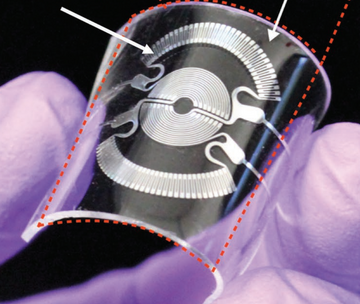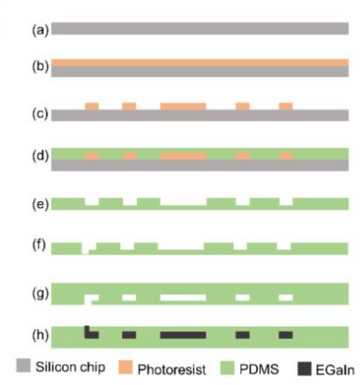Microfluidic Sensing - Liquid Metal-Based Flexible Sensors - Emma Abi-Younes
Soft Sensors
A sensor is a device which can detect changes from its surrounding environment or surrounding objects. Sensors typically consist of three major components which include electrical circuits, conversion element, and a sensing element. Flexible sensors are currently being researched and developed due to the many advantages that come with flexibility of such a device.[1] Figure 1 shows a finished flexible microfluidic diaphragm sensor. These types of sensors can better fit to an object and detect more effectively even when stretched. Soft sensors have many biomedical applications which include health-monitoring, wearable devices, artificial skin, and intelligent robots. The human skin to sensor interface is improved with a flexible and stretchable device since the human body is constantly in movement and a better molding of a device to the body helps reduce sensing errors.

Liquid Metal-Based Soft Sensors
Liquid-metal sensors have many unique properties that allow for the development of effective soft sensors. In comparison to rigid metals, liquid metals are deformable and fluidic. Some important properties of liquid metals include softness, high electrical conductivity, high thermal conductivity, and distinct interfacial chemistry.[3]
A common liquid metal used to create soft sensors is gallium. Gallium has a near-room-temperature melting point, low vapor pressure, low toxicity, metallic thermal conductivity, and electrical conductivity. There are two gallium based liquid metals which include the eutectic gallium-indium and gallium-indium-tin. These types of liquid metal allow the fabrication of flexible on-skin sensors. Soft liquid-metal based mechanical sensors are fabricated by encapsulating liquid metal within microfluidic channels made of poly(ethylene terephthalate) (PET), poly(dimethylsiloxane) (PDMS), or other silicones.
Microfluidic Technology for Fabrication
A method of fabricating a liquid-metal soft circuit is through microfluidic technology. Microfluidic technology allows for the fabrication of stable, uniform, and sealed liquid-metal circuits. A common microfluidic technique is shown in Figure 2. To produce a raised pattern model, photolithography must first be performed. After photolithography, a mixture of PDMS and curing agent is distributed on the patterned surface to create a device via replica molding. Inlet and outlet areas are created in the surface. Then, sealing of the microfluidic channels is done through plasma bonding.[4] Plasma bonding occurs when the PDMS is oxidized using oxygen plasma. The plasma is responsible in removing hydrocarbons through a chemical reaction with oxygen radicals and ions. This results in silanol (SiOH) groups on the patterned surface, increasing the surfaces hydrophilicity and wettability.[5] The PDMS is then placed onto another oxidized surface to create a strong sealed bond. Liquid metal is then injected into the microfluidic channels.[4]

Applications
Temperature sensors helps in the monitoring of temperature changes which can give insight on human health conditions and physiological activities. Temperature sensors work by detecting changes in infrared radiation energy and send a signal to an electric circuit to determine the objects temperature. Liquid metal-based sensors with gallium are ideal for temperature sensing because there is high thermal conductivity, operation over a wide range of temperatures, durability, and functionality even after deformations of the sensor. In soft based sensors, there is minimal thermal energy lost through the microfluidic channels and human skin which results in accurate temperature readings. Also, a soft and flexible sensor can conform better to the human body and is able to sense temperature changes after deforming. For instance, an Apple watch has the ability to sense movement of the body, but if the watch was bent or deformed in any way, it would stop working.[4]
Mechanical sensors are able to detect mechanical deformation in the form of pressure, strain, and torque. A mechanical sensor works in a way that input pressure, strain, and torque is converted into an electrical output signal. Within these devices there are strain gauges, which are tight electrical conductors and if there is a change in shape, resistance changes. Based on resistance change, pressure can be measured. Signals are collected by these sensors based on the amount of applied mechanical force and changes of the electrical properties.[6] Gallium based liquid metal mechanical sensors with microchannels have been fabricated and used for pressure, curvature, and strain sensing. Different designs of mechanical sensors contribute to variability in sensitivity and detection capabilities of the sensor itself. Figure 3 shows two different designs have varying microfluidic geometry to examine and compare pressure and strain.[4]

Bibliography
[1] Ren, Y.; Sun, X.; Liu, J. Advances in Liquid Metal-Enabled Flexible and Wearable Sensors. Micromachines 2020, 11(2), 200. https://doi.org/10.3390/mi11020200
[2] Gao, Y.; Ota, H.; Schaler, E. W.; Chen, K.; Zhao, A.; Gao, W.; Fahad, H. M.; Leng, Y.; Zheng, A.; Xiong, F.; Zhang, C.; Tai, L. C.; Zhao, P.; Fearing, R. S.; Javey, A. Wearable Microfluidic Diaphragm Pressure Sensor for Health and Tactile Touch Monitoring. Advanced Materials 2017, 29(39), 330. https://doi.org/10.1002/adma.201701985
[3] Baharfar M.; Kalantar-Zadeh K. Emerging Role of Liquid Metals in Sensing. ACS Sensors 2022, 7(2), 386-408. https://pubs.acs.org/doi/10.1021/acssensors.1c02606
[4] Zhang, L.; Gao, M.; Wang, R.; Deng, Z.; Gui, L. Stretchable Pressure Sensor with Leakage-Free Liquid-Metal Electrodes. Sensors 2019, 19(6), 1316. https://doi.org/10.3390/s19061316
[5] Jiang X.; Zheng H.; Fourdin S.; and Hammond P. Polymer-on-Polymer Stamping: Universal Approaches to Chemically Patterned Surfaces. Langmuir 2002 18 (7), 2607-2615. https://pubs.acs.org/doi/10.1021/la011098d
[6] FUTEK. Pressure Transducer Sensor. https://www.futek.com/pressure-transducer (accessed 2022-05-05).
